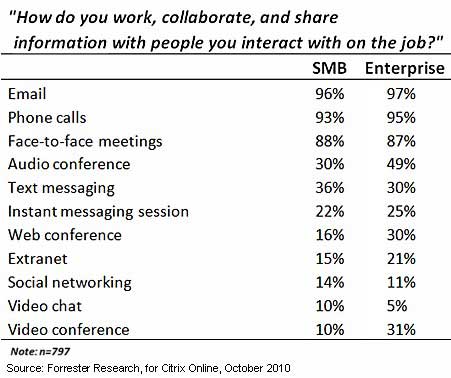Gen-X information workers—and not those in the younger Gen-Y generation—constitute the majority of people who use social networking for business, followed closely by Boomers age 55 and older, according to a survey from Citrix Online. Moreover, the use of social and collaboration technologies among Gen-Y workers lags behind older groups.
Among all surveyed information workers—those who use a computer for work—Gen-Y workers use social networking the least frequently: 40% of surveyed Gen-Y workers (age 18-34) who use social media for business do so daily, compared with 50% of workers age 55+.
Moreover, older Boomers (age 55+) have increased their business use of social media 79% over the past year.
Workers of all ages are using social media tools more than they did a year earlier, and cite the following objectives for doing so:
- Communicating, establishing rapport, and building trust with colleagues: 64%
- Collaborating and sharing information with colleagues: 65%
More UK Workers Use Social Media
A larger percentage of workers in the UK use social media daily: 57% say they use social networking tools to work, collaborate, and share information with co-workers on the job. Workers from other surveyed countries use social media daily, at the following levels:
- Germany: 45%
- US: 43%
- France: 35%
- Australia: 13%
Below, other findings from the five-country report conducted by Forrester Research, for Citrix Online, a division of Citrix Systems.
Gen-Y workers are the least likely to share information via text message (26% do so, compared with 47% of those age 55+). Gen-Y's are also the least likely to use video conferencing, video chat, and Web conferencing tools.
Collaboration Tools on the Job
Among today's highly-dispersed workers, email is the most common way to work, collaborate, and share information with people on the job, both at small- to mid-sized businesses (96%) and enterprise organizations (97%). Traditional methods of interaction—phone calls and face-to-face meetings—are also widely preferred among SMBs and enterprise organizations.

Many workers—especially those in enterprise organizations, use tools such as audio conferencing (49%), and video conferencing (31%), and Web conferencing (30%) to communicate and collaborate. Tools such as video chat are also gaining popularity: 10% of SMBs use the collaborative tool, as do 5% of enterprise organizations.
The use of collaborative technologies is growing as well. For example, 56% of workers who video chat tools in business now use them more than they did last year. Team document-sharing sites (55%) and Web conferencing (52%) have also registered increases in adoption in 2010.
Looking for real, hard data that can help you match social media tools and tactics to your marketing goals? The State of Social Media Marketing, a 240-page original research report from MarketingProfs, gives you the inside scoop on how 5,140 marketing pros are using social media to create winning campaigns, measure ROI, and reach audiences in new and exciting ways.
American Workers Hold More Meetings
Americans have more meetings—and pay more attention to them: 90% of US workers meet in person to communicate and build relationships (more than any other surveyed country). Of those, 51% meet daily, compared with 31% of French workers.
Fully three in four American workers (75%) say it's very important to pay attention in meetings to decide on a course of action, compared with 50% of the French workers.
Though in-person meetings are common, they're not necessarily effective: 84% of all workers surveyed have such meetings, but only 45% say they're very satisfied that in-person meetings achieve desired results, and only 30% say meetings are very efficient.
Younger Workers Value Meetings Less
Gen-Y workers are the least likely to say meetings are efficient. Only 29% of Gen Y workers say meetings used to decide on courses of action are very efficient, compared with 45% of older Boomers who say so.
Gen-Y workers are the least likely to pay attention in meetings: Just 51% say it's very important to do so in meetings to decide a course of action.
No Multitasking
Multitasking during meetings is considered rude: 83% of workers say side conversations are unacceptable during meetings, and 77% frown on those doing other work on a computer or smartphone during a meeting.
Most workers still like to look each other in the eye: 75% of Germans say they like to see others during meetings, whereas 55% of American workers say the same, though they have the most in-person meetings.
About the data: Forrester Research conducted the September 2010 online survey of 797 information workers, evenly split between the US, UK, France, Germany, and Australia. Information worker is defined as anyone who uses a computer for work. Respondents were of all ages (Gen-Y: 18-30; Gen-X: 31-44; younger Boomers: 45-54; older Boomers: 55+) and from various industries.



